Table of Contents[Hide][Show]
A nourishing homemade baby formula using safe, whole ingredients. This recipe was developed and tested by Dr. Mary Enig, a PhD Nutritionist and originally published in Nourishing Traditions cookbook in 1996. It was formulated to match breastmilk as closely as possible and is also suitable for infants. Source: Weston A. Price Foundation
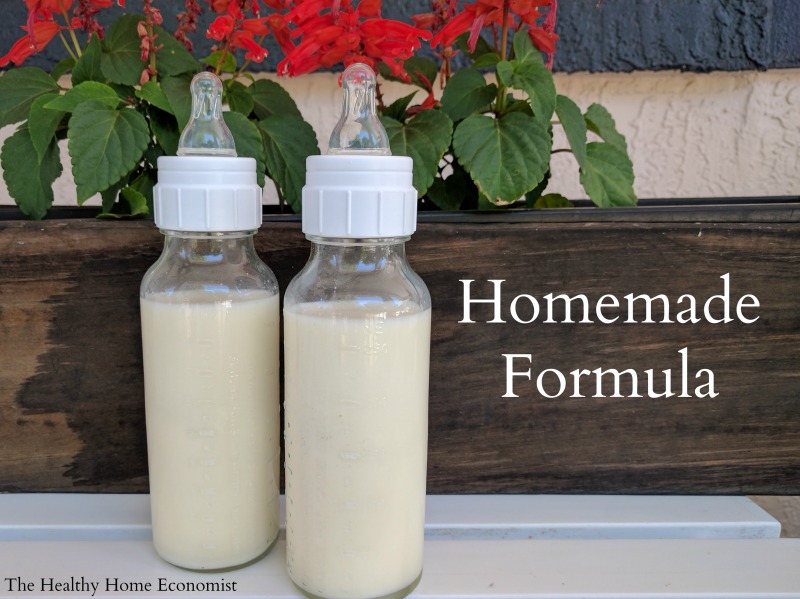
There is no doubt that breastfeeding your baby is the best option for the child’s long-term health and development. Human breastmilk from a well-nourished mother is the perfect food for baby. However, in circumstances where the child is adopted or the Mother finds herself unable to breastfeed, formula feeding becomes necessary. In those cases, homemade baby formula is best.
Using a baby formula recipe that closely matches the nutritional profile of breastmilk is a far better choice than even organic baby formula from the health food store. More on this below.
Note: Donor programs are widely available for human breastmilk. But, the diets of the donor mothers are unknown and most likely nutritionally insufficient. In addition, breastmilk banks pasteurize the donated breastmilk which destroys much of the nutritional benefit. Unless you are fortunate to have a trusted and direct donor milk source in your community, avoid this option!
Dangers of Commercial Formula
Commercial formulas are always a poor choice for a number of reasons. First of all, formula manufacturers line the cans with the chemical BPA. This substance disrupts hormone development and is a probable contributor to early puberty in girls, and ADHD, urogenital abnormalities, and other ills in boys.
The European Food Safety Authority found that canned commercial formula is a significant source of BPA for infants, exposing the child to 13mcg of BPA per kg of body weight per day! BPA-free formula cans are no better. The chemical BPS is typically used instead which is just as dangerous.
Beware that manufacturers pack even organic commercial formula like Earth’s Best in BPA cans. Worse, they use organic brown rice syrup as the primary sweetener which is known to be frequently contaminated with arsenic.
In addition, all commercial milk formulas are processed at extremely high temperatures which violently denature the fragile milk proteins, render them allergenic, and add carcinogens to the final product. Soy infant formula is the worst. Obscenely high processing temperatures not only denature the proteins but large levels of phytic acid in soy block mineral absorption by the infant. Moreover, soy-based plant estrogens disrupt the hormonal development of the baby!
It seems that for the concerned Mother who is unable to breastfeed, learning how to make baby formula at home with safe, pure ingredients is the most prudent way to go!
Why Make Homemade Formula Even if You Are Breastfeeding
In the video below, I show you how to make your own safe, healthy raw milk homemade formula for your baby.
The recipe I follow was originally published in the cookbook Nourishing Traditions in 1996 and developed by Dr. Mary Enig.
Even though I breastfed each of my children for at least 2 years, I made this exact formula for my own children when I was away for the day or the evening as pumping was not an option that worked well for me.
I even used this homemade formula for an entire day once when I had some dental work done and was advised to pump and discard for 24 hours.
As a result, even successfully breastfeeding Moms can use this wonderful homemade formula as a supplement when necessary to their own nutrient-dense breastmilk!
It is advised that even breastfeeding Mothers have the ingredients for this formula on hand for an emergency. If Mom is sick or otherwise unable to nurse, Dad can step in and make this safe alternative until Mom is back on her feet. It takes a few days to a week to gather all the ingredients together to make this formula, which is why I advise having them on hand at all times.
Homemade Most Nutritious
The image below lists the reasons why it is worth it nutritionally to make formula yourself for your precious baby!
You can order all of the required ingredients for the homemade baby formula in one package from this reputable, vetted source.
Moms who have successfully used this formula feeding your children, please post about your experience in the comments section to encourage those who are considering it and need some Mom to Mom encouragement!
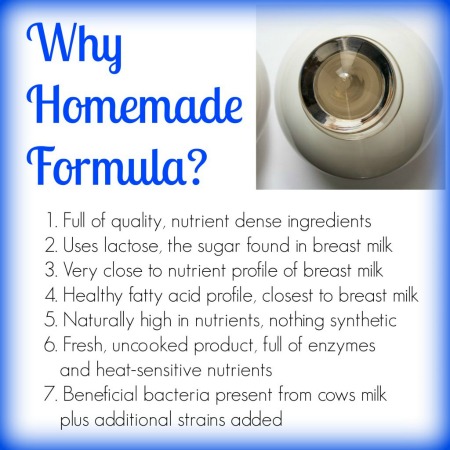
Where to Source Quality Milk
The most widely available grass-fed milk around the world is from cows. This is usually the most budget-friendly and easily sourced milk for this recipe for homemade formula.
If only goat milk is available in your area, this recipe for goat milk baby formula can be used instead. When using milk from ewes, please refer to the linked article for an adjusted recipe; one of the benefits of sheep milk is that it is higher in healthy fats than either goat or cow milk.
Camel milk formula is another option that is a particularly digestible form of dairy and growing in popularity around the world.
Alternatively, you can use low temp (vat) pasteurized, non-homogenized whole milk cultured with a piima or kefir starter. Then substitute the piima milk or kefir for the raw milk portion of the formula recipe. Cold-pressed raw milk also must be cultured before using it as it contains no probiotics.
Do NOT use ultrapasteurized (UHT) milk even if organic as it is too highly processed and extremely allergenic!
It is also best to avoid all types of powdered milk for this recipe. The factory process of making milk powder reduces nutrition considerably and denatures it, which makes it more likely baby will have an allergic reaction.
Dairy Allergy Option
If all types of dairy prove unsuitable for your baby, make this nondairy baby formula recipe instead. It uses a base of homemade bone broth as a substitute for milk. It is important not to utilize a plant-based or otherwise vegan baby formula recipe.
Avoid buying bone broth to make the dairy-free formula. Make it yourself! Manufacturers of commercial bone broth, even if authentic, may water down the end product. This is apparent if it does not gel when chilled in the refrigerator.
Many brands have toxic packaging issues as well. If you must buy it in a pinch, see my shopping guide page for vetted brands that are safe.
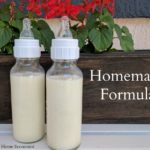
Homemade Baby Formula Recipe (for infants too)
A nourishing baby formula recipe you can make at home with safe, whole ingredients developed and tested by a PhD nutritionist to match breastmilk as closely as possible. Also suitable for infants.
Ingredients
- 2 cups raw cow milk OR organic whole milk yogurt
- 1 7/8 cups filtered water
- 1/4 cup liquid whey
- 4 Tbl lactose
- 1/4 tsp Bifidobacterium infantis powder
- 2-4 Tbl raw or pasteurized cream
- 1/2 tsp cod liver oil unflavored
- 1/4 tsp butter oil unflavored
- 1 tsp sunflower oil preferably organic
- 1 tsp extra virgin olive oil preferably organic
- 2 tsp virgin coconut oil preferably organic
- 2 tsp nutritional yeast
- 2 tsp gelatin
- 1/4 tsp acerola powder
Instructions
-
Fill a 2 cup Pyrex measuring cup with filtered water and remove 2 TBL (this will give you 1 7/8 cup water).
-
Pour about half the water into a pan and turn burner on medium.
-
Add the gelatin and lactose and let dissolve, stirring occasionally.
-
When gelatin and lactose are dissolved, remove pan from heat and add the rest of the water to cool.
-
Stir in the coconut oil and butter oil until melted.
-
Put remaining ingredients in a glass blender.
-
Add the water mixture and blend for about 3 seconds.
-
Place formula in glass baby bottles or a glass jar and refrigerate.
-
Before giving to baby, warm glass bottle in a pan of hot water or a bottle warmer. NEVER microwave baby bottles!
Recipe Video
Recipe Notes
If using raw cow milk from holstein cows, use 4 Tbl of extra cream (otherwise use 2 Tbl extra cream).
If choosing to make this homemade formula with camel milk, be sure to include 4 Tbl extra cream as camel milk is lower in cream than cow milk.
Do not use high oleic sunflower oil. Use only the brand recommended in the ingredients list which is cold pressed, organic, unrefined, and low oleic.
*Do NOT use powdered whey from the store as it is denatured. Avoid whey from making cheese as it will curdle the formula.
*Do not substitute pasteurized or powdered milk as these are heavily processed, denatured and allergenic foods.
*Do NOT use ultrapasteurized (UHT) cream. It is highly allergenic. Raw or pasteurized cream is acceptable.
*Do NOT use fish oil or krill oil instead of high vitamin cod liver oil as they do not contain any Vitamin D and very little to no Vitamin A.
Collagen powder may be substituted for the gelatin in a pinch (more on peptides in baby formula in this article).
If you are wondering where is the iron in homemade baby formula, this article provides an explanation.
If baby experiences constipation using this formula, try adding 1 tsp of molasses to each batch. This should help move things along.
How to Transition to DIY Formula
Once you’ve viewed the video, gathered the ingredients, and made your first batch, how do you feed it to your baby for the first time?
It is important not to switch all at once as this can cause gas, excessive spit-up, or an uncomfortable change in diaper habits such as constipation or overly loose stools.
Start by giving your baby three-quarters of the old formula blended with one-quarter of the homemade. Try this ratio for a day or two and see how your infant responds.
If no digestive upset or major change in diaper habits occurs, increase the amount to a 50-50 blend of old formula to homemade. Observe for another day or two as before.
If no major issues, increase once again to three-quarters homemade formula to one-quarter old formula. If baby does well on this blend for a third time, you are ready to fully transition to the homemade formula.
At any time during the transition, symptoms of intolerance emerge, back up to the previous successful blend ratio and stay there for a day or two before attempting to increase once again.
Homemade Formula FAQ
Weston Price Foundation
Feeding an Adopted Baby
Traveling Tips with Baby Formula Made at Home
Iron in Baby Formula
Collagen Peptides instead of Gelatin for Homemade Formula?


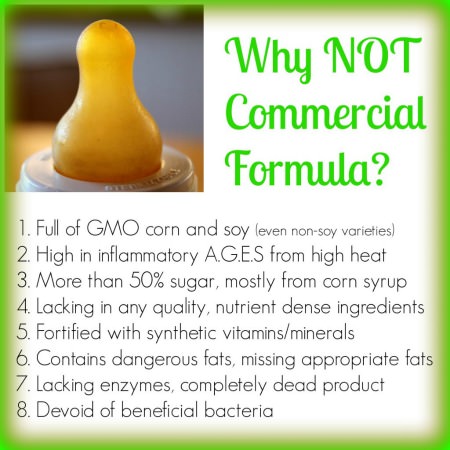
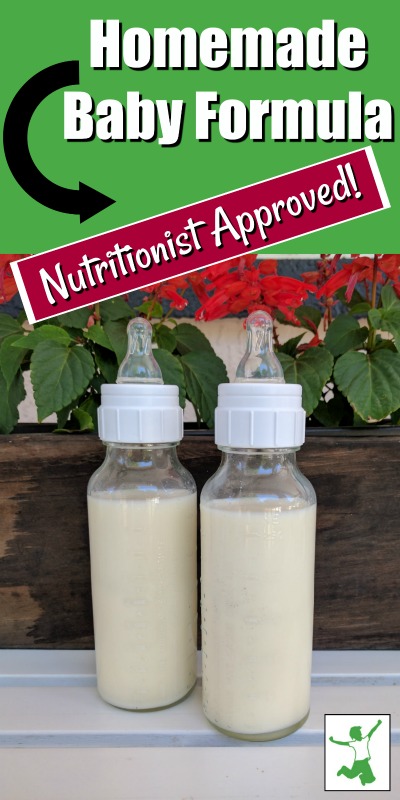






So can you freeze this in bottle ready amounts like we do with breastmilk?
Yes, freezing works great.
Hi Sarah,
wanted to check on what kind of cream do you recommend to use ? Are there any recommended brands ?
There is no brand .. you must buy from a small farm locally. The cream from the store is no good as it is ultrapasteurized. Contact your local Weston Price Chapter Leader for a list of small farms in your area: westonaprice.org
In the case where I am unable to reach a farm( I will give it a shot of course but I live in the city), what would be the best solution ?
In a pinch, you can just get extra raw milk and skim the cream off the top of the milk to add to the formula. You can also mail order raw cream. Order the shopping guide from the Weston Price Foundation. It costs $1 westonaprice.org
Hi Sarah, thanks for your help. One last question: what is the best source to obtain tea towels from ? do you have a link to where I can get it on the web ?
Hi Sarah, one other question… is this raw milk formula doable if we were to leave for vacation out of country – say to mexico ? Can we get good quality raw milk there ?
Or can we revert to commercial formula for the time when we are away ? How do babies do on commercial formula after they were switched to raw milk formula ?
is there a recommended way to transition the baby at 7 months of age to raw milk from commercial ?
Hi Regina, I have no idea what the raw milk availability in Mexico is or whether it would be safe to use it there. I have no experience using commercial formula (other than one bottle of soy formula which basically put my baby in a stupor for 12 hours so I never used it again) so am not able to comment on transitioning either to it or from it.
Can this formula be frozen if needed or will it affect the nutritional value?
Freezing is fine.
Hello,
I am curious what the storage rules are for this formula. Does it have to be used within 24hrs after being made ? Seems like I have to prepare it fresh daily …
After heating the bottle, within how long would it have to be used ?
Hi Regina, you can refrigerate the formula and it is fine to use for several days even up to a week if the raw milk was fresh when you prepared it. If the baby doesn’t finish the bottle on the first go, then use it up within an hour or so typically .. treat it with the same safety precautions as leftover food from a meal.
I am very new to Nourishing Traditions and am now trying to gather ingredients for the baby formula for my 6 month old. I have tracked down a local source for raw milk, but they are very low on supply and don’t have cream to offer. Neither of the local health food stores had pasteurized only cream. Can you substitute half and half? I did find pasteurized unhomogonized half and half at Whole Foods. OR is there anything you can do with the cream on top of your raw milk? Ours is from jersey cows so maybe I can do something on my own using the milk.
Hi Alison, don’t use the half and half. Just skim off some cream from the top of a gallon of your local raw milk and use that (milk that you’re not using for the formula).
thanks so much Sarah. makes sense. i’m new to raw milk as well and have never bought cream in my life. loving it though!!!!
Thanks Sarah. Now that spring is approaching our supplier finally has milk to sell again. I am going to spoon the cream of a gallon to use for the formula. Am I able to make the whey from the remaining skimmed milk or do you need the fat in the whey as well. Thanks for all your assistance and time here on this blog!
Hi Alison, yes you can make whey from the raw milk with the cream skimmed off. Just clabber it on the counter for a day or two until it separates then strain the whey through a tea towel.
how exactly do you do that? skimming off the cream off of milk, i tried doing it but it feels like i am just spooning off milk not cream?
What does this formula taste like? I’m curisous to try it because I’ve tried the Meat Based Formula from Nourishing Traditions and my daughter will not drink it because of the taste.
I am unable to get the cod liver oil mixed in properly with the formula. Any tricks? Also, if the baby is being given breast-milk 40-50% of the time, can this formula be given for the rest of the time? My baby seems not to like the formula with the various oils. When I exclude them, she chugs it down. Any ideas why? Can I give her the fats separately?
Thanks,
Ranjani.
Hi Ranjani, it doesn’t have to mix perfectly. If you daughter is older than 3 months, then you can give her the cod liver oil via an eyedropper instead and leave out of the formula.
Hi Sarah,
I’m still waiting for a reply to my above comment.
Thanks.